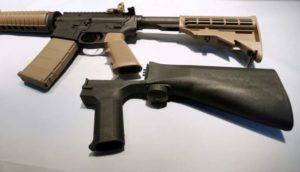Bump Stock Ban [SCOTUS 2024 Update]
After the bump stock legal history below, the case made it to the Supreme Court of the United States and the oral argument was just heard by the court.
The government argued that bump stocks were effectively machine guns because there was one function of the trigger – they argued that the “pulling forward” was the triggering motion and therefor it was a machine gun. However, they admitted in their argument that a shooter ALSO had to keep rearward pressure with their trigger finger – I hope that the court recognizes that this is two distinct actions that are both required to fire the firearm.
Alternatively, I hope that the court looks strictly at the actual trigger and realizes that it is being operated each time the firearm fires.
Here’s a link to the oral argument and the transcript.
Stay tuned for updates as they come in – we’re eager to share and explain the Supreme Court’s decision when it comes.
In this article, we’re going to discuss:
- Bumpstock Ban Background
- Bump-fire Stock Definition
- Machine Gun Laws / Regulations
- Bump Stock Controversy
- Bump Stock Ban Final Rule
- Potential Effects/Loop-holes
Bumpstock Ban Background
In 2018, the Trump administration amended federal regulations concerning machine guns to effectively outlaw “bump-fire stocks” for average gun-owners.
The bump stock ban final rule, which was officially published 12/26/18, defined these bump-fire stocks as “machine guns.”
From that date, individuals must surrender or destroy their bump-fire stocks within 90 days (March 26, 2019) or become felons.
Thankfully, true second amendment organizations, like the Firearm Policy Coalition, have been fighting this rule and this new 6th Circuit Court ruling is the first good news from this fight.
Contrary to popular belief, it is perfectly legal (under federal law) for citizens to possess machine guns as long as the appropriate paperwork has been approved by the ATF and taxes have been paid. However, machine guns (or machine gun parts) manufactured after 1986 can only be possessed by Federal Firearm Licensees (FFLs) or government entities. Therefore, one potential loop-hole to this new rule, as it is to most gun bans, is to get an FFL.
However, it is unclear how/if this will work because the bump-stocks were not made as registered NFA firearms and the ATF seems to interpret some stuff on a whim.
It is important to note that bump-fire stocks were not technically “banned.” Instead, they were considered standard firearm parts (which are largely unregulated) and after the 2018 ruling they were defined as machine gun parts which are highly regulated.
Because these bump-fire stocks were made after 1986, non-FFL citizens will not be able to possess them.
The 6th Circuit US Court of Appeals ruled that ATF’s 2018 determination that bump stocks were “machine guns” was incorrect and that their regulation banning them was illegal.
The people fighting the 2018 bump stock “ban” argued that a lower court should have issued an injunction stopping the rule effectively outlawing bumpstocks while the lawsuit continued. The lower court didn’t issue the injunction (they allowed the rule to stand) and the people fighting the “ban” appealed to a higher court.
Now, the higher court has agreed with the pro-gun groups and has officially determined that the following things were wrong:
- The DOJ (and ATF) incorrectly defined bump-stocks as “machine guns,”
- The DOJ (and ATF) were not allowed to effectively re-write federal law, and
- The lower court should have issued the injunction stopping the “ban” until the matter could be resolved in court.
What is a Bump-Fire Stock?

A bump-fire stock is a device that can be added to a firearm which allows the shooter to shoot a semi-automatic firearm at a much faster rate-of-fire than could normally be attained.
Bump-fire stocks allow a semi-automatic firearm to move rearward inside the stock under recoil (it “slides” upon “firing”) and it allows the shooter to keep their trigger-finger stationary.
If the shooter applies forward pressure on the firearm, then the firearm is allowed to slide forward after it recoils thereby pulling the trigger into the shooter’s stationary trigger-finger.
This might look and sound like a machine gun, but it is still only one bullet per trigger pull. You’ll see why this matters in the definition of a machine gun in federal law below.
Machine Gun Laws / Regulations
In order to understand the effect of reclassifying a piece of plastic as a machine gun, we first must address current machine gun law.
As the law stands (before the 2018 rule went into effect and likely now with this new court ruling), a machine gun is a firearm that fires more than one bullet for every one operation of the trigger. The word “operation” is important (see below).
Typically, this means that one pull of a trigger resulting in one bullet fired is a standard firearm whereas multiple bullets being fired for that one trigger pull equals a machine gun.
There is a nuance in the current machine gun regulations.
The current machine gun regs refer to a “single operation” of the trigger and not a “single pull.” This allows some devices, like binary triggers, to allow a firearm to fire once on the trigger pull and also fire upon the release of the trigger as this is technically two “operations” of the trigger (pull and release).
At the simplest level, machine guns, and machine gun parts, made prior to 1986 can be possessed by individuals under federal law if the proper paperwork and taxes have been filed/paid.
Modern machine guns (those made after 1986), however, can only be possessed by FFLs or government entities.
This is why many gun owners are now getting their FFL (even from their home). Not only would it allow them to be exempted from this bump stock ban, it can potentially exempt them from more gun regulations as most gun control laws (like assault weapons bans) don’t apply to FFLs.
For a more complete explanation of machine gun laws, please see Who Can Own A Machine Gun?
Bump Stock Controversy
Bump-fire stocks were a point of contention after the 2018 Las Vegas mass shooting. The murderer used a bump-fire stock to fire semi-automatic rifles into a crowd of people.
Many called for the ban of such devices (both pro and anti gun). In fact, the NRA specifically asked the Trump administration to increase regulations on bump-fire stocks. This call by the NRA to increase gun laws and restrict these devices has been very unpopular within the gun industry.
On the anti-gun/gun-control side, people argued that these devices circumvented the law and allowed machine gun-like capability while avoiding the controls and regulations surrounding machine guns. This is partly true. Clearly, bump-fire stocks were designed to allow faster rates of fire than most could attain without these devices and they were obviously designed around the current laws concerning machine guns. However, they do not make a firearm into a machine gun – that was unit lthe ATF decided to make a rule declaring them as machine guns, at least.
On the pro-gun side, people argued that the devices where merely parts and did not convert firearms to machine guns. Many thought that bump-fire stocks were stupid (me included), however, it would still be an impermissible infringement on our second amendment rights. I don’t have to own or like a firearm in order to understand that banning these pieces of plastic would be an infringement on our second amendment rights.
After the Las Vegas shooting, President Trump called for the Department of Justice (DOJ) to amend regulations to effectively ban bump-fire stocks. The DOJ then published a final rule banning bump stocks as “machine guns.”
There were two HUGE problems with this.
First, the law makes it very clear (to those of us who can read) that a firearm is a machine gun if more than one projectile (bullet) is fired by a single operation (pull) of the trigger. Although bump stocks allowed for faster firing, they clearly do not change a firearm into a machine gun. Each time the rifle recoils and slides forward in a bump stack the trigger is pulled only one time and only one bullet is fired.
Second, by absolutely changing the definition of a machine gun, the DOJ was changing federal law. This is not legal. Congress, and only Congress, can create or change laws (which, must, of course then be signed by the President). The DOJ is part of the Executive branch under the president and although they are supposed to create regulations to carry out law made by Congress, they are not permitted to make nor change the law as they see fit.
2018 Bump Stock Ban Final Rule
The DOJ, at the direction of President Trump, drafted rules to effectively amend federal laws concerning machine guns in 2018.
Just typing that sentence makes my brain hurt – a federal agency (the Executive branch) may not change laws.
Instead, Congress (the Legislative branch) must create or amend laws which are then approved by the President. Then, and only then, may a federal agency create rules or regulations to carry out that law.
This new rule has been challenged on this procedural impossibility and this new ruling from the 6th Circuit agrees that it was wrong for the DOJ to do this.
However, assuming that President Trump was allowed to circumvent the lawmaking process and make rules by fiat (like a King), which effectively happened as bump stocks have been “banned” ever since, let’s explore what the rule did.
Technically, the rule did not specifically amend language of federal law. However, it does distinctly change agency regulations and definitions of terms to effectively change the meaning and scope of the law.
First, here’s the summary from the language of the rule. Next, we’ll explore what it means.
“The Department of Justice is amending the regulations of the Bureau of Alcohol, Tobacco, Firearms, and Explosives (ATF) to clarify that bump-stock-type devices-meaning “bump fire” stocks, slide-fire devices, and devices with certain similar characteristics-are “machine guns” as defined by the National Firearms Act of 1934 and the Gun Control Act of 1968 because such devices allow a shooter of a semiautomatic firearm to initiate a continuous firing cycle with a single pull of the trigger. Specifically, these devices convert an otherwise semiautomatic firearm into a machine gun by functioning as a self-acting or self-regulating mechanism that harnesses the recoil energy of the semiautomatic firearm in a manner that allows the trigger to reset and continue firing without additional physical manipulation of the trigger by the shooter. Hence, a semiautomatic firearm to which a bump-stock-type device is attached is able to produce automatic fire with a single pull of the trigger. With limited exceptions, the Gun Control Act, as amended, makes it unlawful for any person to transfer or possess a machine gun unless it was lawfully possessed prior to the effective date of the statute. The bump- stock-type devices covered by this final rule were not in existence prior to the effective date of the statute, and therefore will be prohibited when this rule becomes effective. Consequently, under the final rule, current possessors of these devices will be required to destroy the devices or abandon them at an ATF office prior to the effective date of the rule.”
According to the the rule, the current federal legal definition of a machine gun was modified (or, at least DOJ interpretation has changed) to include bump-fire stocks.
First, the DOJ changed their definition of “single function of the trigger” to mean “a single pull of the trigger.”
Second, the DOJ changed the definition of “automatically” to mean “as the result of a self-acting or self-regulating mechanism that allows the firing of multiple rounds through a single pull of the trigger.”
Third, the DOJ “clarified” that their definition of machine guns includes “Bump-Stock Type Devices.”
“…The Department explained that when a shooter who has affixed a bump-stock-type device to a semiautomatic firearm pulls the trigger, that movement initiates a firing sequence that produces more than one shot. And that firing sequence is “automatic” because the device harnesses the firearm’s recoil energy in a continuous back-and-forth cycle that allows the shooter to attain continuous firing after a single pull of the trigger, so long as the trigger finger remains stationary on the device’s ledge (as designed). Accordingly, these devices are included under the definition of “machine gun” and, therefore, come within the purview of the NFA….”
Fourth, the DOJ amended their regulations (which they are allowed to do) to match their changes in definitions above.
Regulations for the Gun Control Act of 1968, the National Firearms Act of 1934, and the Arms Export Control Act are all affected.
Upon the publishing of this rule, non-FFL citizens had 90 days to either destroy their bump-fire stocks or turn them in to an ATF office.
Failure to abide by this (without having an FFL) was a felony and therefore would remove all gun rights from anyone convicted of violating this rule. This is because felons are in the class of people who may not possess any firearms or ammunition called Prohibited Persons.
This means that a person, who merely possesses a piece of plastic and no firearms, would be a felon 90 days after this rule is published.
This was a DRASTIC change in the law outside of the proper rule making process.
Potential Effects / Loopholes
In addition to banning bump-fire stocks for people that don’t have an FFL, the 2018 rule, if it is allowed to stand, could also affect devices like “binary triggers.”
Binary triggers are trigger mechanisms that exploited a technicality in legal definitions.
Binary triggers fire once upon each trigger pull and then again on each trigger release. These binary triggers would allow the firing of more than one round for each trigger pull, however, the law covered “operation” and not “pull” and each pull and release of a binary trigger were seen as distinct operations.
Therefore, the allow one fired round per operation and are not machine guns.
If the 2018 rule on bump fire stocks could stand, then it is possible that binary triggers could be considered machine gun parts and therefore illegal for non-FFLs to possess.
After all, the one word in the law that allowed their use was redefined/modified.
Despite this, the rule specifically says that binary triggers are not affected by the rule, but this is a logical inconsistency – they were only allowed because of the word “operation” versus “pull.” If the definition is changed, then they are likely banned.
If the definition is not changed, then bump stocks aren’t banned.
Right here is the problem with allowing the legal department of ATF take over for writing firearms determinations. The proper group to do this in the ATF, is the group that used to do it, the firearms tech guys… the ones that actually understand firearms.
As for a potential loophole, we’ve covered a possible one so far: becoming an FFL.
We are working with ATF currently to determine whether a previously possessed bump-stock could be registered as a machine gun by an FFL/SOT.
Recent Posts
December 8, 2025
November 29, 2025
November 25, 2025
November 22, 2025





I also listened to the audio when it first happened. And saw the footage of all the weapons on display in the hotel room. Two things stand out as to be out of place. No. 1 the bump stock weapons were laying flat on the carpet. When you fire a weapon at that rate and lay it on the carpet you should see the melted/burned imprint from the hot barrel. There was none. No.2 the shooter had no experience with firing a bump stock as stated he had just purchased them prior the shooting. No. 3 when you are firing a bump stock at a downward or upward angle it is hard to make it function properly because the recoil is out of preportion to the weight of the weapon. No. 4 what was the weapon on the tripod? Was that a belt fed? That would be more feasable as to the set up and the consistant rate of fire that I heard.
The problem with the ATF is that they are intentionally shady about their definitions and I understand that they reserve the right to individually decide on case by case basis who is a fealon and who isn’t. But if you are going to F’ing charge me with a fealony, you better clearly define it! Pressure needs to p
Be put on thusnorganization to clearly define wtf their difinitions are like any other law enforcement agency does.
great
hello.com
Perhaps the author should have mentioned that Obama made end runs on Congress ALL THE TIME, including gun control EO’s.
Glad I got rid of mine way back in August of 2018 after I saw how it worked I just didn’t have any interest in wasting a ton of ammo to play. I still think it’s just a warm fuzzy feeling to the gun grabbers instead of and safety issue.
Ryan how is this not a taking of property subject to just compensation?
I don’t know. There is some precedent that allows the banning of certain dangerous products without compensation. I don’t agree with it, but it’ll be interesting to see what happens.
Great article. The only part of it that I have an issue with is your paragraph: “Bump-fire stocks were a point of contention after the Las Vegas mass shooting. The murderer used a bump-fire stock to fire semi-automatic rifles into a crowd of people.”
Maybe I missed it, but I don’t recall any level of proof that the shooter actually used one of the bump fire stocks which he owned to shoot into that crowd, several of which were present in his room. Law enforcement in Las Vegas has not been very transparent as all it would take is to Sure, several were on rifles in his room. Law enforcement could easily have a press conference, show the rifle with the bump fire stock installed then produce one of his rifles which were in his room, then have a firearms expert state that the rifle was used during this crime from forensic examination of that rifle. If the killer did not use a bump fire stock, just had them in his room, then there is not one crime recorded as being committed with a bump fire stock. The alleged purpose of this “rule” is to reduce crime/make the public safer, thus reasoning becomes invalid. Thanks for the good article
Having listened to the recordings of the shooting many times, as have most of us, there is no realistic doubt that bump stocks were used. Before any news mention of bump stocks, I told several friends that he used bumpstocks. Perhaps it is not convenient, but it is nonetheless true.
He had 14 bump stock-equipped guns with him in the room.
Source: LVMPD Criminal Investigative Report of the 1 October Mass Casualty Shooting (start on page 96)
https://www.lvmpd.com/en-us/Documents/1-October-FIT-Criminal-Investigative-Report-FINAL_080318.pdf